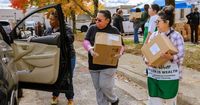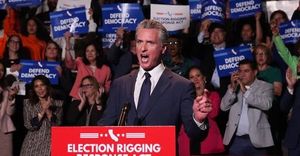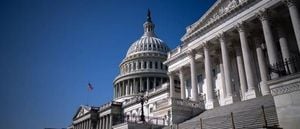As the calendar turns to November 2025, a storm is brewing at the intersection of politics and daily life for millions of Americans. The nearly monthlong federal government shutdown, which began in early October, has now triggered a crisis for the country’s largest food assistance program, the Supplemental Nutrition Assistance Program, or SNAP. According to the US Department of Agriculture (USDA), funding for SNAP will disappear starting November 1, leaving about 40 million low-income Americans without the monthly support they rely on to buy groceries. The fallout is expected to ripple through communities, food banks, and local economies in ways not seen in recent memory.
SNAP, a lifeline for those living paycheck to paycheck, is suddenly in jeopardy. The USDA warned on October 10 that it would have “insufficient funds” to pay full benefits by the end of the month, and later confirmed that “the well has run dry. At this time, there will be no benefits issued November 01.” The program, which provides an average payout of about $6 per person per day, is not just a federal nutrition program—it’s a critical economic stabilizer, according to a letter from the US Conference of Mayors. The organization, representing over 1,400 city leaders, stressed that when benefits are delayed or reduced, city economies absorb the shock through increased food insecurity, higher demand on emergency food providers, and additional strain on municipal budgets and public health systems.
The shutdown has prevented Congress from approving additional spending, halting the federal transfers to states that fund SNAP. Although the program is administered by individual states, the bulk of the money comes from Washington. In a letter to states on October 10, the USDA instructed them to hold off on sending data to vendors like grocery stores that participate in the program “until further notice.” This means that people may not be able to reload their SNAP cards at the store, or may experience significant delays in processing—an added blow to those already struggling.
Food banks, the country’s last line of defense against hunger, were already stretched thin before the shutdown. Rising food prices and cuts to federal programs earlier in 2025 had left them with less to give, even as more Americans turned to them for help. According to the Agriculture Department’s latest report, more than 47 million Americans face food insecurity at some point during the year. Feeding America, a nationwide network of food banks and pantries, says millions more don’t fully fit that definition but still rely on charitable food programs for support.
“When that social safety net breaks above us, we will be there to do as much as we can,” Andrea Williams, president of the Oregon Food Bank, told reporters. “And it will not be enough.” Visits to Ms. Williams’ network of food pantries in Oregon have soared by 50 percent over the last two years. In the Washington D.C. area, Radha Muthiah, head of the Capital Area Food Bank, reported that pantry visits have doubled since before the pandemic. The demand, she said, is overwhelming their ability to respond.
Earlier this year, the Trump administration cut nearly $1 billion in federal aid for anti-hunger programs, including one that supplies food directly to food banks. The effect has been stark. “Demand is up, food is down,” John Sillars of the Second Harvest Food Bank in southern Louisiana said simply. Food pantries can provide only one meal for every nine supplied by federal food assistance. “It means people will go hungry, and in particular, kids and seniors and rural communities,” Williams warned.
For many, the situation is reminiscent of the early days of the pandemic, when business closures and layoffs sent Americans scrambling for help. But Jill Dixon, director of the Food Depot in northern New Mexico—the state with the highest proportion of SNAP recipients—believes it could be even worse. “I think it has the potential to be bigger than that,” she said, noting that in previous shutdowns, there was always an expectation that the federal government would protect SNAP payments. Now, that safety net seems to be missing.
States are scrambling for solutions. Virginia’s Governor Glenn Youngkin declared a state of emergency in anticipation of the cutoff. California’s Governor Gavin Newsom announced plans to call up the National Guard to support food banks. In Louisiana, where 18 percent of the population relies on SNAP—the second highest proportion after New Mexico—lawmakers are poised to use reserve funds temporarily to cover missing payments. Still, these measures are only stopgaps.
Meanwhile, the USDA’s $5 billion SNAP contingency fund, which could cover about 60% of a month’s benefits, remains untouched. Agriculture Secretary Brooke Rollins has declined requests from Democrats to release the reserves or transfer other departmental funds, stating that the reserve is for “true emergencies,” mainly natural disasters. The Center on Budget and Policy Priorities, a think tank focused on policies for low-income families, has argued that the federal government is legally required to use the contingency fund. “The Administration itself admits these reserves are available for use. It could have, and should have, taken steps weeks ago to be ready to use these funds,” the organization said in a statement.
The political blame game has intensified, with both Republicans and Democrats pointing fingers over responsibility for the shutdown and the looming benefits cut. In the meantime, ordinary Americans are left to cope. Social media is awash with posts about stretching meals and finding alternative food sources. “Start heading to the food pantry and your churches now, because the sooner you go, the more food you can get,” advised Arvilla Beckworth, known as Single Mom Coach on TikTok, in an online video. “As soon as people find out that the benefits are not paying out, they’re going to those same pantries.”
Federal workers, too, are feeling the pinch. The Trump administration’s slashing of the federal workforce earlier this year had already increased food insecurity in areas with large populations of government employees. Now, with paychecks halted, the need is even greater. At food distribution events in Beltsville, Maryland, on October 25 and 26, cars lined up for blocks. After just 45 minutes and 320 boxes given away, the site ran out of food, leaving many federal employees empty-handed. “To see all these federal employees have to do this—it breaks my heart,” said Maria Staunton, a volunteer who had been furloughed from her job as an auditor. “With a federal job, it used to be that you didn’t have to worry. It used to be a very stable job.”
As November dawns, the country’s most vulnerable—children, seniors, rural communities, and federal workers—stand at the edge of a precipice. The coming weeks will test not only the resilience of America’s food safety net but also the nation’s political will to protect it.




